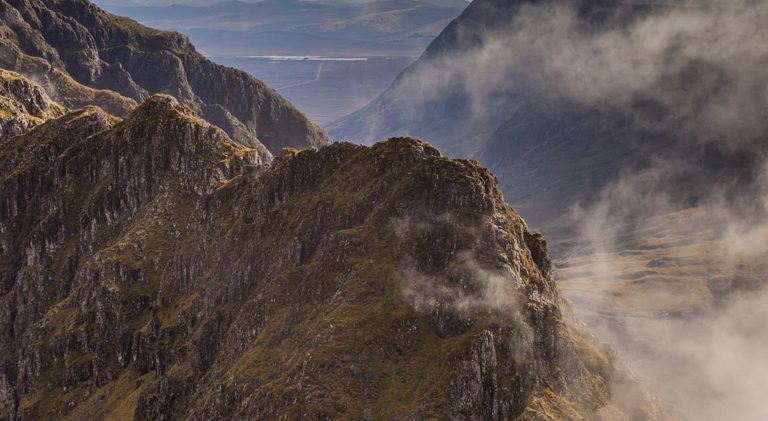Psychologists and motivational speakers have long told us the benefit of stepping out of our comfort zone to enable personal growth. There are loads of way can do this from chatting to a stranger to learning a new skill. If you’re a fit hiker with a head for heights why not push yourself by stepping up to a ridge walk, such as a guided traverse of Aonach Eagach ridge.
Story Stages
Why a ridge walk?
If you’ve done most of your hiking on lower ground, taking a walk along a mountain ridge can be an exhilarating experience and an excellent way of leaving your hiking comfort zone. It’s not one for the faint-hearted or the inexperienced though. Mountain ridges are by their very nature exposed to the elements and flanked by steep drops. While you don’t need to be a seasoned climber to attempt a ridge walk, you will benefit from being confident on higher ground and being physically fit.
Where to go
In the UK there are several notable ridges that you could choose to tackle. In England, Striding Edge on Helvellyn in the Lake District is a classic Grade 1 scramble. It is considered a good starting point for anyone who is new top scrambling, and there are alternative routes along the ridge which can avoid much of the scrambling.
Crib Goch in the Snowdonia National Park is another Grade 1 scramble, although it is considered more difficult than Striding Edge. Some of the difficulty comes from the fact that the route is less well defined on Crib Goch, which can lead to hikers losing their way and becoming stuck. If you’re feeling very energetic you can continue after Crib Goch and complete the whole Snowden Horseshoe, which includes the summit of Snowden itself as well as Y Lliwedd.
Finally, we come to Aonach Eagach in Glen Coe, the narrowest ridge walk on the British mainland, and a bit of a superstar among scramblers. This is a Grade 2 scramble, but it is a challenging Grade 2 and like all these ridges shouldn’t be underestimated. Anyone thinking about leaving their comfort zone would certainly find that a traverse of Aonach Eagach fits the bill. However, there is a fine line between discomfort and recklessness, which is why for a challenge of this magnitude you should consider engaging the services of a qualified mountain guide who can help you complete it in safety.
What’s the difference between, hiking, scrambling and climbing?
When talking about some of the ridge walks available to you we’ve described them as ‘scrambles’, so it’s probably worth explaining what this means.
If you’re a hiker you will have a clear idea of what ‘hiking’ means. Hiking is a bit more strenuous than a gentle walk. When we picture a hike, we think of more challenging terrain than a walk, maybe with changes in elevation, uneven ground and few if any constructed paths. You’ll probably also be out for much longer, maybe hiking for hours or days on end. All of this would tend to give you a level of physical fitness which would make the move to scrambling relatively straightforward.
Scrambling is best described as a midway point between walking and climbing. Essentially when you need to use your hands to hiking on a steep and/or exposed route you’re scrambling. Scrambling routes are graded from 1 to 3, with Grade 1 scrambles being the least difficult. Grade 1 scrambles shouldn’t require you to use any technical equipment such as ropes. When you get to Grade 2 you may need ropes in some parts, and routes will tend to me more exposed. Grade 3 scrambles, as you may have guessed by now, are trickier still and are often considered moderate climbing routes. You will definitely ropes, and you should get some climbing experience – for example on an indoor wall – before considering attempting one.
Which brings us to climbing itself. Here you are constantly moving vertically and you are making much more use of your upper body There is a tendency to think that climbing requires more technical skills and equipment than scrambling, however, as you’ve seen, harder scrambles will often require equipment to be tackled safely. There is in a reality a bit of an overlap between the categories, so you should consider them an indication of the skills you may need but talk to an expert before attempting any route, and don’t go alone if you are unsure.
Safely out of your comfort zone
Ridge walks are exciting and challenging. As a way to push yourself as a hiker, they are hard to beat. But as we’ve touched on it’s important to stay safe. The grading for scrambles tends to refer to good weather conditions, and those conditions can change quickly. A wet, slippery piece of rock is an entirely different proposition to the same route on a warm sunny day. This is another reason why tackling these with the help of a qualified guide is advisable. If you approach these routes with a professional you will be able to stretch yourself without putting yourself in danger. You’ll then be able to take this sense of achievement off the ridge and into the rest of your life.
